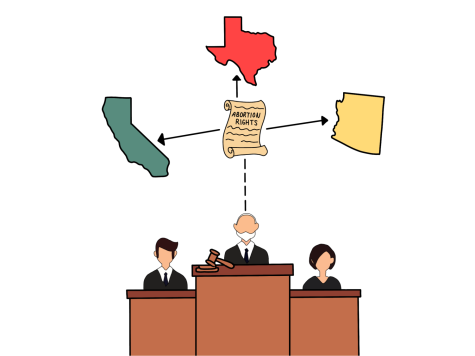On May 2, 2022, a leaked Supreme Court draft opinion stated that the majority of the court voted to overturn the 1973 court case Roe v. Wade., sparking a variety of reactions, both jovial and discontented. While some protested, calling for the right to abortion, others used this as an opportunity to further pressure the courts to follow through with their decision.

Abortion can be seen as a polarizing topic, with conservatives and liberals generally favoring one side over the other. Technically speaking, conservatism is defined as a “tendency to preserve what is established,” and the Republican Party views typically correlate with this notion. According to a 2021 study of political typology by Pew Research Center, U.S. adults who identify as Republican or Republican-leaning are typically more conservative, while those who consider themselves Democrat or Democrat-leaning are more liberal. Junior and president of the Democrat Club, Athena Raskin, also correlates conservatism with the Republican Party.
“I would say that conservatism is just the general political view of God and in keeping with old traditions,” Raskin said. “The Republican Party has recently shifted to [become] more conservative in recent years.”
As the leaked document signals the overturning of Roe v. Wade, a landmark decision regarding liberty and the constitutional right to privacy, the U.S. as a whole may seem like it is shifting towards more conservative values. According to a May 2022 Bark survey, 32 percent of students feel that the U.S. is turning more conservative, while 25 percent think the U.S. is becoming more liberal.
However, the U.S. population is becoming more liberal socially. Support for same-sex marriage has increased by 43 percent from 1996 to 2021, and the majority of Republican citizens supported gay marriage for the first time in 2021. Opposition to gay marriage has long been a conservative view, but the growing support from the Republican Party displays a clear shift toward more liberal values.
Furthermore, 2021 was the first year that less than 50 percent of Americans belonged to a house of worship, such as a church, synagogue or mosque. In contrast, membership in 1999 was at 70 percent. Religion is strongly tied to conservative values, as expressed in the Religious Right movement of the 1970s. During this time, religious leaders responded to the counterculture movements by advocating for a return to traditional views of nuclear families and bans on abortion as well as same-sex marriage. Evangelicals are a major force in the anti-abortion movement, as 74 percent of white evangelical protestants in 2022 believe abortion should be illegal, according to Pew Research. The decline of religious affiliation may contribute to the rise of social liberalism in the U.S. and greater acceptance of abortion in the U.S.
In fact, most U.S. citizens do not support a full ban on abortion. According to a March 2022 survey by Pew Research, 61 percent of Americans said abortion should be legal in all or most circumstances, while 37 percent believe it should be illegal in all or most circumstances. Despite this general data expressing the majority opinion, there are numerous factors woven into each side, such as how far along the pregnancy is and how the baby was conceived.
Given that most Americans support the legality of abortions, the Supreme Court’s leaked draft opinion does not reflect the views of the majority of people in the U.S., an idea that may extend further than just the topic of abortion.
“I think [President Donald] Trump got a lot of support from the pro-life movement and from the conservative movement in general, as they were one of his big blocks of voters. I think that he appointed judges that he knew would satisfy conservatives in America,” Raskin said.
Three out of the nine current Supreme Court Justices were nominated by President Trump. This indicates that one-third of the highest court that claims to “protect civil rights and liberties” was put in power by a singular president. Furthermore, this president did not receive the popular vote when elected, falling short of Democratic candidate Hillary Clinton by almost 2.9 million votes. The Senate that approved justices Neil Gorsuch, Brett Kavanaugh and Amy Coney Barrett was also not representative of the U.S. majority. During Trump’s presidency, the Senate majority was Republican, while the voter majority remained more Democratic. The Supreme Court’s purpose is to act as a nonpartisan interpreter of the Constitution who is not affiliated with a particular political party, a concept now threatened by these actions.
The Republican Party also presented inconsistent procedures for appointing justices in the last months of the Trump presidency. In February 2016, during President Barack Obama’s last year in office, Justice and conservative Antonin Scalia died, leaving a vacancy for Obama to fill. However, conservative Senator Mitch McConnell led a successful block on Obama’s nomination of Merrick Garland stating, “The American people should have a voice in the selection of their next Supreme Court Justice. Therefore, this vacancy should not be filled until we have a new president.”
In contrast, when Justice Ruth Bader Ginsburg died in September of 2020, less than two months before the 2020 presidential election, McConnell supported Trump’s nomination and agreed to replace Ginsburg with anti-abortion conservative Amy Coney Barrett. Raskin points out various flaws in the Senate and Supreme Court systems.
“I don’t agree with the fact that in the Supreme Court judges can serve for life. I think that there should always be rotation so that there are new and fresh perspectives,” Raskin said. “For the Senate, I do not think that it’s representative. I think the House of Representatives and how it represents each state’s population is much more democratic.”
Each state receives two seats in the Senate despite ranges in population size. For instance, a state such as Wyoming, with a population of approximately 600,000, elects the same number of senators as California, with a population of about 40 million.

However, the Chairman of the Republican Party of Marin, Jack Wilkinson, expresses an opposing view of the Senate’s equal distribution.
“If all of [the government] was based on population, then we’d have a tyranny of the majority, which is why we have the Constitution and the way it was constructed to avoid the tyranny of the majority,” Wilkinson said.
Wilkinson further claims that the 1973 Roe v. Wade decision was “flawed” and “faulty from the start” in terms of constitutionality.
“The Supreme Court never should have made that decision because they made a law, [which the Supreme Court is not supposed to do]. This violates the Constitution and violates the three branches of government. [Abortion] is not mentioned in the Constitution at all,” Wilkinson said. “[Abortion] is a states’ rights issue, and [the Roe v. Wade ruling] never should have been established.”
Although the decision to allow abortions would be voted on by the states, Raskin highlights a possible caveat of this system.
“A lot of the states where there are risks to abortion rights have very unfair voting practices, such as not enough polling stations in areas with predominantly people of color or not allowing voting by mail. I think that is very skewed,” Raskin said.
In the 2021 legislative sessions, more than 440 bills restricting voting access were introduced in 49 states, while at least 19 states passed 34 laws restricting voting between Jan. 1 and Dec. 7, 2021. In states such as Texas and Arizona, which enacted restrictive voting bills of this nature, state elections may not be representative of the citizens’ opinions, as people of color are often disproportionately affected by these laws. A study published in American Politics Research found that voters of color typically lack access to necessary IDs, and a study in the University of Chicago Press Journals expressed that “strict identification laws will disproportionately stop a minority, otherwise willing set of registered voters from voting.”
As states regain the power to make decisions regarding abortion, and the Supreme Court acts on more conservative values, the increasingly socially liberal people of the U.S. will inevitably invoke push-back.
“I think that one implication [of the possible Roe v. Wade overturn] will just be a larger outcry from pro-choice people in the government. Especially with the election of Joe Biden and how Democrats hold the majority in both the House [of Representatives] and the Senate, it shows that most Americans don’t agree with [the decision in the draft],” Raskin said.
Although the decision is not yet finalized, the 6-3 conservative majority in the Supreme Court is “pulling the United States back into a prior era without regard for changing notions and understandings of equity, equality and fairness,” according to Sarah Warbelow, the legal director for the Human Rights Campaign.
“By declaring its intention to reconsider earlier rulings on abortion …, the GOP majority is inverting the Court’s usual motivation for revising precedent,” Warbelow told The Atlantic. “Historically when the Court has done so, it has been to rectify past wrongs in a way that creates greater rights for all Americans. But the cases that the Court is now considering … are not about expanding rights; they are about restricting rights [and] perpetuating a very narrow view of who should be able to operate fully within the world.”












